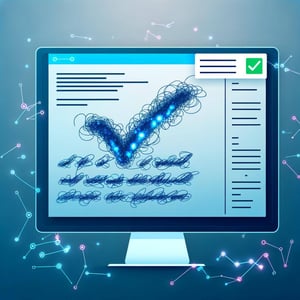Understanding Automatic Signature Verification for Election Mail Ballots

Written at May 3, 2024 12:29:31 PM by Justin O'Donnell
In recent years, the security and integrity of elections have become topics of significant public interest and debate. One of the critical elements ensuring the legitimacy of voting, especially with the increasing prevalence of mail-in ballots, is the process of signature verification. Automatic signature verification technology plays a pivotal role in this process, offering both efficiency and accuracy. Let’s dive into what automatic signature verification entails and why it's crucial for election mail ballots.
What is Automatic Signature Verification?
Automatic Signature Verification (ASV) is a technology used to compare the signature on a mail ballot with the signature on file for a registered voter to validate the voter's identity and eligibility. This process is primarily handled through software that utilizes machine learning and image processing techniques to analyze the characteristics of signatures.
How Does It Work?
The process begins when a voter submits a mail-in ballot with a signed affidavit or envelope. Upon receipt, election officials use ASV systems to scan the signature. The technology then compares this scanned signature against a signature database, which typically contains signatures from the voter's registration records, previous ballots, or other government documents.
ASV software analyzes various signature features such as:
- Shape
- Loop height and width
- Pen lifts and pressure points
- Writing speed and rhythm
- Stroke order
The system applies algorithms that quantify similarities and differences, scoring the comparison. If the score meets a predetermined threshold, the signature is considered valid. If it falls short, the ballot may be set aside for further review or trigger a follow-up with the voter.
Why Use Automatic Signature Verification?
Efficiency: Manual signature verification is labor-intensive and time-consuming. ASV allows election officials to process a large volume of ballots quickly, which is crucial in large-scale elections.
Accuracy and Consistency: Human verification can be subjective, influenced by fatigue, bias, or variability in judgment. ASV provides a consistent standard for signature verification, reducing the potential for human error.
Scalability: As the volume of mail-in voting increases, ASV technology can scale according to demand without requiring a proportional increase in human resources.
Security: By automating the verification process, the risks of tampering or unauthorized access are minimized. Systems can be designed to maintain stringent security standards and audit trails.
Challenges and Considerations
While ASV offers numerous benefits, there are also challenges to consider. These include:
- False Rejections: Like any automated system, ASV is not foolproof. Legitimate ballots might be rejected due to poor signature quality or changes in a person's signature over time.
- Voter Notification: Jurisdictions must ensure that voters whose ballots are flagged by ASV systems are promptly notified and given ample opportunity to confirm their identity and rectify the situation.
- Legal and Privacy Concerns: The use of personal signatures and their storage raises privacy issues. Adequate security measures must be in place to protect voter data.
The Future of ASV in Elections
As technology evolves, so too does the potential for improving ASV systems. Ongoing advancements in machine learning could enhance the accuracy of signature verifications, while developments in cybersecurity can further secure the process. Additionally, increased transparency about how signatures are processed and verified can help boost public confidence in mail-in voting systems.
Election authorities continue to refine these technologies to balance efficiency with the imperative of upholding voter rights and ensuring the integrity of the electoral process. As mail-in voting becomes more widespread, the role of automatic signature verification will likely grow, representing a critical component of modern electoral systems.

Justin O'Donnell
BlueCrest


0